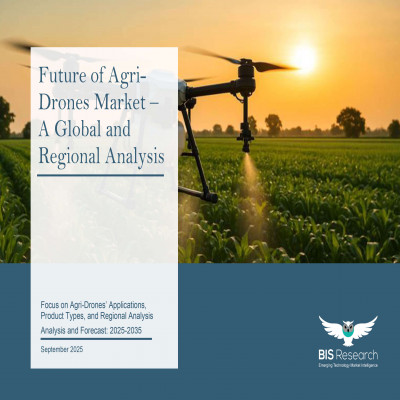Introduction to Asia-Pacific Future of Agri-Drones Market
The Asia-Pacific future of agri-drones market is projected to reach $26,676.6 million by 2035 from $1,054.9 million in 2024, growing at a CAGR of 34.19% during the forecast period 2025-2035. The APAC agri-drones market is being shaped by several emerging trends, including the rapid adoption of precision agriculture to optimize inputs and enhance crop productivity. Drones that can monitor crops in real time, spray adaptively, and spot pests early are in high demand as a result of the push for climate-smart farming, which supports regional sustainability programs. With autonomous drones reducing the need for manual fieldwork, automation is becoming more and more significant in the face of the pervasive labor shortage. Large-scale, coordinated operations are also made possible by technical advancements like swarm drones, while predictive analytics and better farm management choices are made possible by integration with IoT and big data platforms.
By establishing uniform airspace laws and certification procedures, the changing regulatory environment throughout Asia-Pacific is also starting to legalize drone activities. Agri-drones are positioned as a major force behind next-generation agricultural solutions in the Asia-Pacific region as a result of these trends, which collectively demonstrate the convergence of cutting-edge technology, data intelligence, and sustainable agriculture.
Market Introduction
The market for agri-drones in Asia-Pacific (APAC) is expanding rapidly due to the region's growing use of smart farming and precision agriculture technology. Agri-drones are being used for crop monitoring, pest and disease detection, soil analysis, and precision spraying in nations including China, India, Japan, and Australia. This helps farmers increase crop production, lower input costs, and maximize resource use. In order to support sustainable and climate-smart agriculture, cutting-edge elements like artificial intelligence (AI), the Internet of Things (IoT), GPS-based systems, and machine learning allow for real-time data collecting, predictive analytics, and automated farm management.
The growing desire for autonomous drones, which lessen reliance on manual labor for repetitive tasks, and labor shortages in rural areas are other factors driving the industry. Adoption is rising in nations like China, Japan, and South Korea because to government initiatives supporting digital agriculture, smart agricultural programs, and subsidies. Field mapping, yield estimate, and resource-efficient farming are being improved by innovations including variable-rate spraying systems, swarm drones, and multispectral imaging sensors.
Precision fertilization, yield prediction, crop health monitoring, and irrigation management are some of the main uses of agri-drones in APAC. The APAC agri-drones market is expected to grow rapidly due to technology advancements and rising awareness of sustainable farming methods, positioning the area as a center for cutting-edge digital agricultural solutions.
Market Segmentation:
Segmentation 1: by Application
• Crop Monitoring/Scouting
• Soil Health Assessment and Carbon Tracking
• Precision Spraying
• Livestock Monitoring
• Insurance and Claim Assessment
• Others
Segmentation 2: by Drone Type
• Fixed-Wing Drones
• Multi-Rotor Drones
• Single-Rotor Drones
• Hybrid Drones (Fixed + Rotary)
Segmentation 3: by Payload
• Small Payload (<2 kg)
• Medium Payload (2-20 kg)
• Large Payload (20-50 kg)
• Heavy Payload (>50 kg)
Segmentation 4: by Region
• Asia-Pacific
APAC Agri-Drones Market Trends, Drivers and Challenges
Market Trends
• Precision Agriculture Adoption: Increasing use of drones for targeted spraying, crop monitoring, and soil analysis.
• Climate-Smart Farming: Drones enabling sustainable farming practices, such as early pest detection and adaptive irrigation.
• Automation & Autonomous Drones: Rising deployment of autonomous drones to reduce dependence on manual labor.
• Swarm Technology: Coordinated drone operations for large-scale field management.
• Integration with IoT & Big Data: Real-time monitoring, predictive analytics, and data-driven decision-making.
• High-Resolution Imaging & Multi-Spectral Sensors: Enhanced crop health assessment and yield prediction.
• Digital Agriculture Initiatives: Adoption driven by government programs in China, Japan, India, and South Korea.
Key Market Drivers
• Labor Shortages: Rural workforce constraints increasing the need for drone-assisted automation.
• Rising Food Demand: Growing population and food security concerns driving efficient farming solutions.
• Cost Optimization: Drones reduce input usage (fertilizers, pesticides, water), lowering operational costs.
• Technological Advancements: AI, machine learning, and GPS integration improving drone capabilities.
• Government Support & Subsidies: Incentives and regulatory frameworks promoting smart agriculture adoption.
• Sustainability Goals: Focus on reducing environmental footprint through precision farming.
Market Challenges
• Regulatory Barriers: Inconsistent drone regulations and certification requirements across APAC countries.
• High Initial Investment: Cost of advanced drones and supporting technologies can be prohibitive for smallholders.
• Technical Expertise: Need for trained personnel to operate drones and analyze data effectively.
• Connectivity Issues: Limited internet/IoT infrastructure in rural areas affecting real-time data transmission.
• Weather Dependency: Adverse weather conditions can disrupt drone operations and reduce efficiency.

